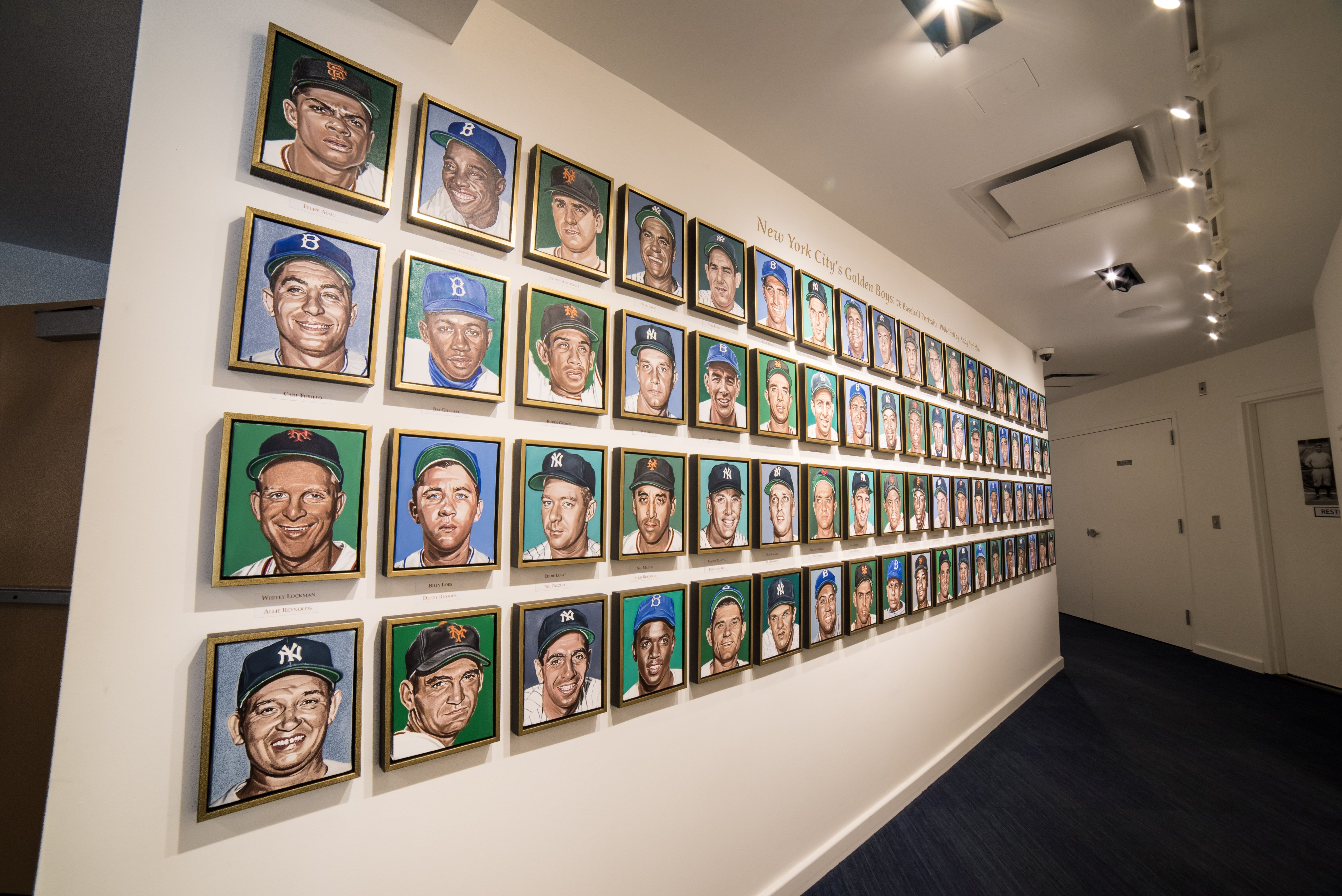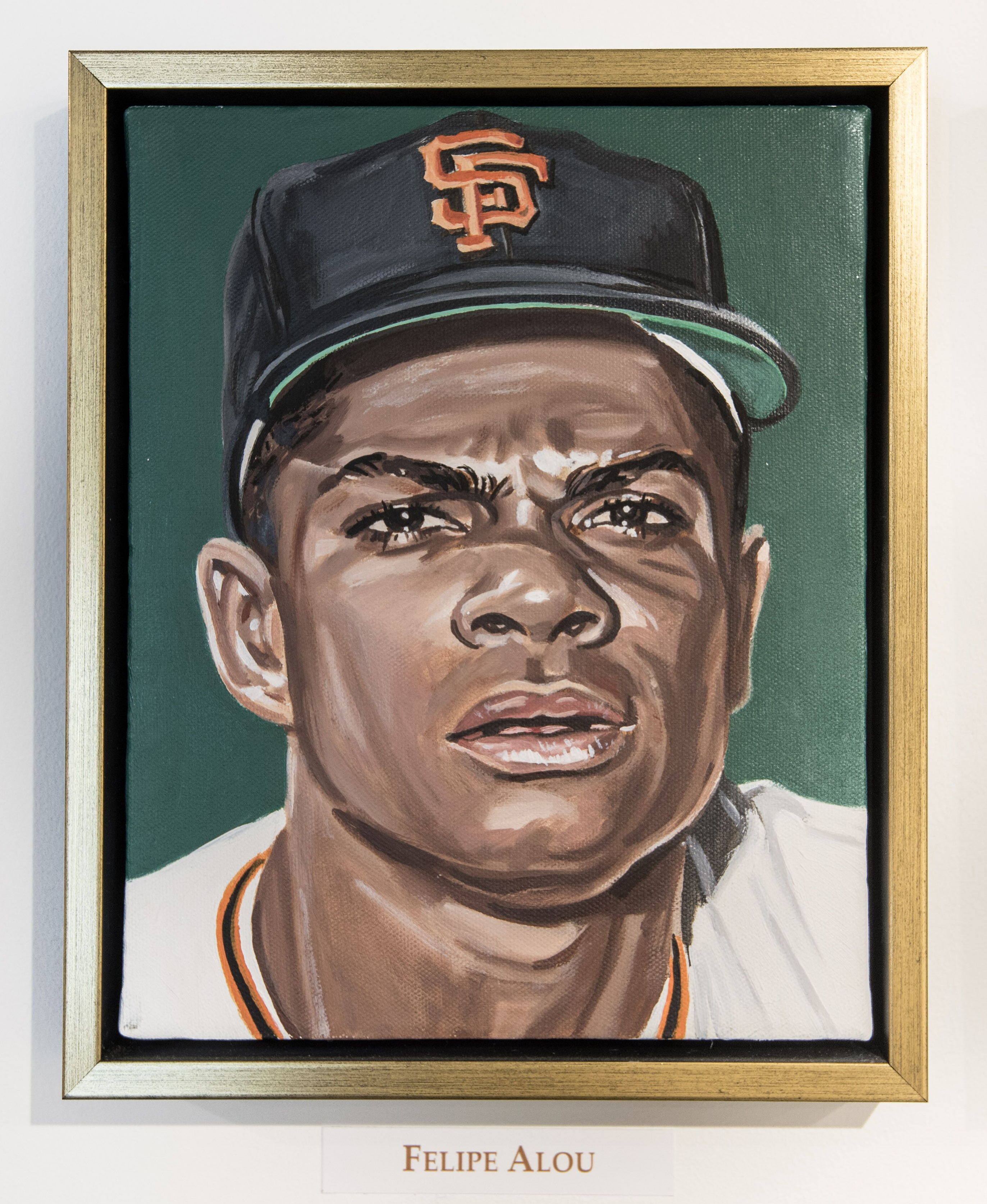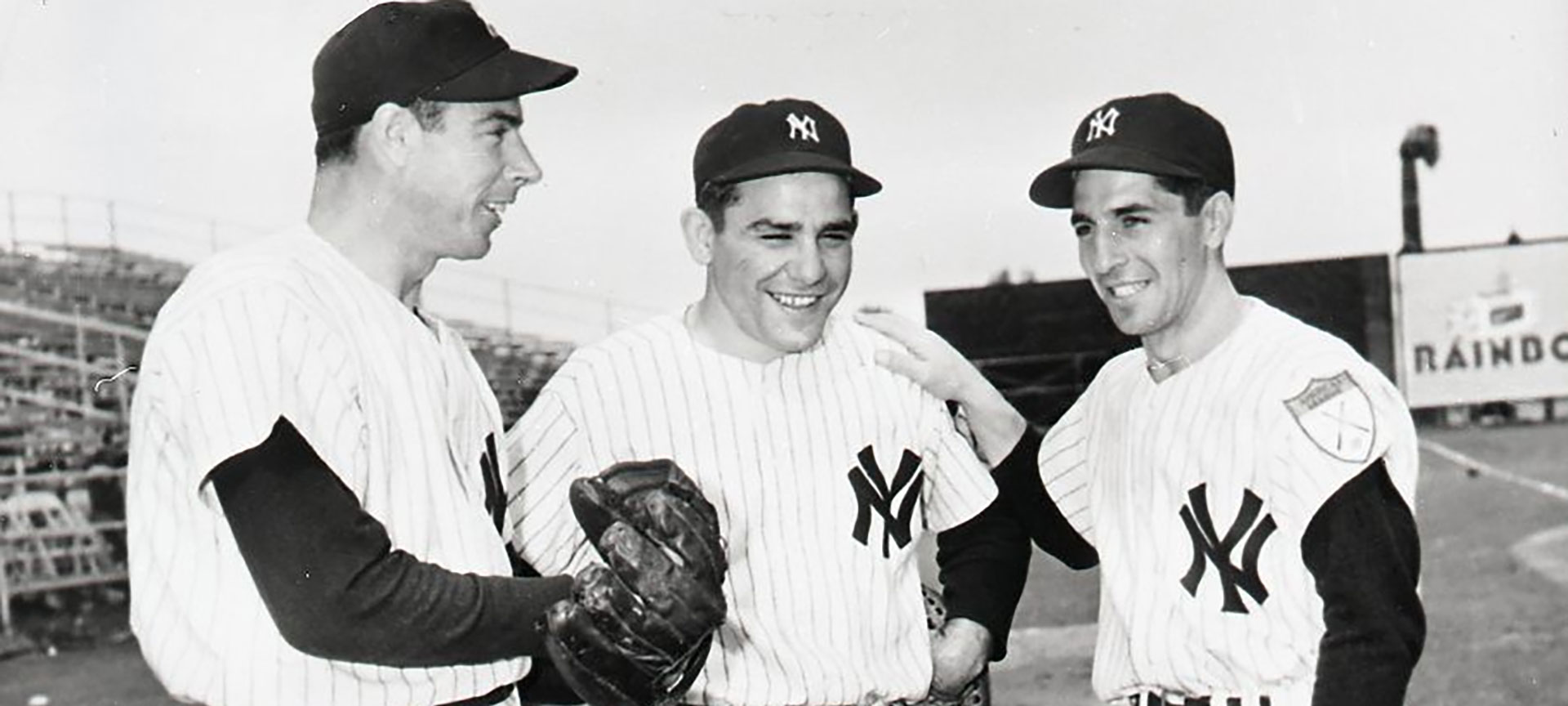3. American Sport/Immigrant Players
After completing this or multiple sections of this lesson plan, please take 5 minutes to complete the survey at the bottom of this page. Your feedback will be extremely valuable for future curriculum updates and additions.
Part 3A:
Explain to students that they will now be doing a Gallery Walk. In this activity, groups of four to six students will take a few minutes at each station, reading and discussing the content.
After the groups have had a chance to complete the gallery walk, come together as a class. Ask the groups what they found in each of the stations, which represent stages in the immigrant experience of Yogi Berra’s father, Pietro. Ask the class as a whole the following questions:
- Where did Pietro Berra’s immigrant journey begin?
- Why do you think he left his European home?
- Describe the conditions in which Pietro Berra traveled.
- Who might have been traveling with him in steerage class?
- What do you think it was like to arrive at Ellis Island?
- Why do you think Pietro chose to settle in “The Hill’ neighborhood of St. Louis?
- What hardships do you think Pietro and other Italian immigrants faced in the United States?
- How would you describe Yogi Berra’s experience growing up in St. Louis?
- In what ways do you think Yogi Berra’s life was shaped by growing up in an immigrant community?
- How do you think a career in baseball “changed everything” for the son of Italian immigrants?
Part 3B:
Show the class the following clip from an episode of Ken Burns’s Baseball series. Instruct students to take notes while watching. Ask students the questions below.
Questions for Students:
- Why did the Imperial Government of Japan reject baseball around the time the United States joined the war effort? What is it about baseball that Japan wanted to disassociate itself with?
- What was Bob Feller’s feeling about joining the war effort?
- For a young Italian American immigrant like Yogi Berra, why might joining the war effort have been an important moment in assimilating into American life? Why do you think that Yogi might have felt obligated to enlist?
- In what ways do you think Yogi Berra’s involvement at D-Day (the Invasion of Normandy) made him somehow more American? How do you think it affected his status as a baseball star?
Part 3C:
Questions for Students:
- How does this statement reflect challenges of the immigrant experience?
- How do you think the manager’s referencing Yogi as “The Ape” relates to the anti-immigrant cartoons from earlier in the lesson? How does it relate to the discrimination that some immigrants and people of color faced because of their apperance?
- How do you think a climate of prejudice might have affected Italian Americans hoping to succeed in the United States?
Making Connections: Do people ever have trouble pronouncing your name? (How does this make you feel?) If not, maybe you have a friend or family member who has had this experience? Do you or somebody you know ever go by a different name or a nickname in order to avoid mispronunciation or confusion?
*Suggested supporting information:
*Reasons why many Americans were prejudiced against Italians:
- Italians were associated with organized crime, the mafia
- Italians were Catholics while many Americans at the time were Protestant
- The Red Scare caused association of Italians with radical political ideologies such as socialism, communism, Marxism, anarchism (e.g. Sacco and Vanzetti).
- Different appearance and different culture of Italian immigrants from White Anglo Saxon Protestants Americans (WASPs) — i.e., Americans of fair skin/hair in appearance.
- Many Italians have darker skin and hair that is curly. These features are similar to African Americans.
Part 3D:
Have students watch the following clip, “The Immigrant Athlete.” In this segment, sports writer Kavitha Davidson discusses the ways in which sports have historically given the public another way of thinking about immigrants. After viewing, ask the class the questions that follow, discussing them as a group.
Questions for Students:
- Based on what you learned earlier in the lesson about political cartoons representing immigrants, what do you think Kavitha Davidson means when she says that Irish immigrants were often not considered white?
- What, in Davidson’s view, did sports do to “humanize” the immigrant? Can you explain how that might be true?
- Do you have any present-day examples of immigrant athletes being welcomed in the U.S. because of their achievements in sports?
Suggested activity:
Research on the Cultural Impact of athletes of immigrant backgrounds:
Have the students conduct research on past athletes from immigrant families (example: Fernando Valenzuela, Masanori Murakami, Roberto Clemente, Hideki Matsui, Sammy Sosa, etc.) or current ones (Jeremy Lin, Giannis Antetokounmpo, Shohei Ohtani, etc.) How have these athletes impacted the perception of their communities in the United States? (examples: Linsanity, Fernandomania, etc.)
Part 3E:
Give your students Handout #3, which includes three sections: A) a list of Italian American entertainers, their professional names followed by their birth names B) a comparison of how many Italian Americans entered U.S. politics in 1946 as opposed to how many played baseball with the 1946 Yankees C) a list of Italian Americans on the 1946 New York Yankees.
After distributing Handout #3, have the class form small groups. Ask the groups to read through the contents and answer the questions that follow.
As a conclusion to this section, have students watch the following clip featuring New York Yankees historian Tony Morante. After viewing, ask students to reflect on what Italian American baseball players meant to Tony Morante as an Italian American boy growing up in New York City.
Questions for Students:
- Why is representation important? What does it mean to have athletes and people of influence/role models who look like you?
- Is it important to have diversity represented in sports and why?
Part 3F:
In this final section, students will look at Latin American immigration, considering more recent changes. Have students look at the graph below, asking them to look for shifts in immigration patterns over time. Ask the class the questions that follow.

Questions for Students:
- Can you locate the peak in Italian immigration to the United States?
- What has happened with European (Italian, German, Irish, etc.) immigration by the year 2000?
- Where are the greatest number of immigrants coming from between 1980 and 2016?
- What do you think cultural traditions associated with American life, such as baseball, “the national pastime,” mean to immigrants during periods of heightened immigration? Use Yogi Berra as an example, and consider Tony Morante’s comments.
- Why might a career in baseball be viewed as the ultimate path to assimilation for young male immigrants, or even those hoping to immigrate? Why might it be perceived an exceptional way to “become American”?
- What does the graph tell us about changes in the demographics of Major League Baseball?
Have students watch the clip from Ken Burns’ Baseball series and answer the questions that follow.
Questions for Students:
- What about Roberto Clemente’s television appearance was most moving to the Latino writer Marcos Breton? Why do you think this was so?
- In the clip from Baseball, we hear that, “It was not until the 1980s that Major League teams began to fully open their doors to talented players from outside of the United States.” How might this change affect Major League Baseball?
- What are some of the issues that could affect the culture of Major League Baseball as more players come to the sport from outside of the U.S., from non-English speaking backgrounds?
Part 3G:
Tell the class that in Major League Baseball today, 31% of the players are Latin American, with that percentage rising to 50% in the Minor Leagues. Discuss with the students how this increase in Latin American players parallels immigration patterns. By way of example, explain to the class that in the Yogi Berra Museum & Learning Center there is a series of painted portraits by Andy Jurinko entitled New York City’s Golden Boys: 76 Baseball Portraits, 1946-60. Show students the photograph below of the Museum’s paintings, and ask them the question that follows.

Andy Jurinko’s series of paintings, “New York City’s Golden Boys: 76 Baseball Portraits, 1946-60,” at the Yogi Berra Museum & Learning Center
Question for Students:
Remembering that 31% of the players in today’s Major League Baseball are Latin American, offer a speculative answer to the following question: how many among the 76 athletes depicted—a group considered the best players on New York teams between the years 1946 and 1960—do you think are Latin American?
To the teacher: Answering this question will involve guesswork for most of the students, but welcome all answers.
After students have given their answers, let them know that four of the 76 are Latin American. That’s 5.26%. Explain that all four were considered trailblazers. Now show them the individual portraits, reading the players’ names aloud.
Questions for Students:
- In what ways do Felipe Alou’s grievances reflect some of the issues faced earlier in the century by Italian Americans like Yogi Berra?
- What does baseball mean for a player like Alou coming from a country with a struggling economy?
- Based on Felipe Alou’s article, in what ways did Latin American players face many of the same issues faced by African American players?
- In what ways is language an issue for Major League players coming from outside of the United States? How is language a major obstacle for immigrants to the United States in general?
- How are the experiences of Latinx immigrants similar to those of other immigrants to the U.S. (Italian, Chinese, etc.)?
CONCLUDING DISCUSSION QUESTIONS:
Ask your students to think about immigration issues going on in America today. Do they see any similarities between what they have just learned in this lesson and what they are seeing/hearing about in the media? Do they recognize any patterns of discrimination or racism against immigrants in the United States by individuals or the government in the present day?

Rubén Gómez

Sandy Amorós

Orlando Cepeda

Felipe Alou
Explain to students that the last of these players, Felipe Alou, a celebrated Dominican player who also became a manager, was an outspoken voice for the rights and needs of Latin American baseball players.

Cover of Sport magazine, 1963
Ask students to read aloud, popcorn style, from the following quotes drawn from Felipe Alou’s 1963 Sport magazine article, “Latin American Ballplayers Need a Bill of Rights.” Then, as a group, answer the questions that follow.
“In my country there is practically no industry, and very little work. We are ballplayers; it is the only thing we can do. Take away baseball from us in the winter, and you take money away from us.”
“I receive a nice salary from the Giants, but I am not rich. I send money home to my mother and father. My father’s family is in bad shape. I have uncles, aunts, and cousins who are in terrible shape, out of work, no money. I help.”
“We need somebody to represent us who knows what goes on in the Latin American countries. He does not have to be Latin. He does not have to speak Spanish. He does have to see the conditions of these countries, face to face. He has to understand the economic conditions, the poverty.”
“When I was young, my family—mother, father, four boys and two girls—lived in a wooden shack. We had to go a mile to the river for water. We had no car or truck. I carried water on my head and shoulders.”
“Not being able to speak English hurts Latin players in advancing their career . . . . But far worse than the language barrier are the insults thrown in the faces of Latin ballplayers. It is said that Latin ballplayers ‘don’t care.’ That Latin players ‘don’t hustle.’ Latin players ‘are lazy.’ Or—and this is the worst—Latins have ‘no guts’.”
“I think it is foolish and dangerous to label any people or any nation or any race as having more or less courage, or more or less desire to excel than any other group.”
“It is not only in the South. One night in 1959, in Pittsburgh, Orlando Cepeda and I went to a downtown restaurant after a game. We were dressed very well, I think. The head waiter came up to us and said, ‘You looking for a job? We have nothing for you.’ We told him we wanted to eat. He wouldn’t let us inside.”
“It may come as a surprise to some people—and as a shock to the San Francisco Giants—but I do not expect to stay in baseball much longer. Perhaps I’ll change my mind, but right now I plan to retire before I am 32. . . I want to own a farm and have some cows. That is the life I want, not playing baseball at night, away from my home and family, in a country where I must resign myself to being an outsider.”
Questions for Students:
- In what ways do Felipe Alou’s grievances reflect some of the issues faced earlier in the century by Italian Americans like Yogi Berra?
- What does baseball mean for a player like Alou coming from a country with a struggling economy?
- Based on Felipe Alou’s article, in what ways did Latin American players face many of the same issues faced by African American players?
- In what ways is language an issue for Major League players coming from outside of the United States? How is language a major obstacle for immigrants to the United States in general?
- How are the experiences of Latinx immigrants similar to those of other immigrants to the U.S. (Italian, Chinese, etc.)?
Give your students Handout #4 and ask them to form small groups. Have them read the article below as a group and answer the questions that come at the handout’s end.
CONCLUDING ACTIVITY:
Ask your students if they are aware of any immigration issues going on in America today. Ask if they see any similarities between what they have just learned in this lesson and what they are seeing/hearing about in the media.
To the teacher: Allow for an open forum and encourage discussion amongst your students. Remind them of the “Ground Rules” established earlier in the lesson unit (Part 1B) and reaffirm that the class will honor them.
Reflection Question for Key Terms/Vocabulary:
Write a short paragraph about Yogi Berra’s life, making use of the Key Terms defined in the pre-lesson activity.
Extension Activities:
- Research an issue relating to immigration today, relating it to Yogi Berra’s experiences as an Italian American. Suggest some ways in which the conflicts around immigration might be addressed, explaining your strategies.
- Write a short research paper about another immigrant who has been involved in American sports.
Lesson Plan Home:
Immigration, Baseball, America: Dreams of Belonging
Section 1:
Immigration: High Hopes & Hard Realities
Section 2:
A New Home: Experiences & Communities
Post-Lesson Survey
Please complete this 2-minute, post-lesson survey. Your feedback will be extremely valuable for future curriculum updates and additions.


